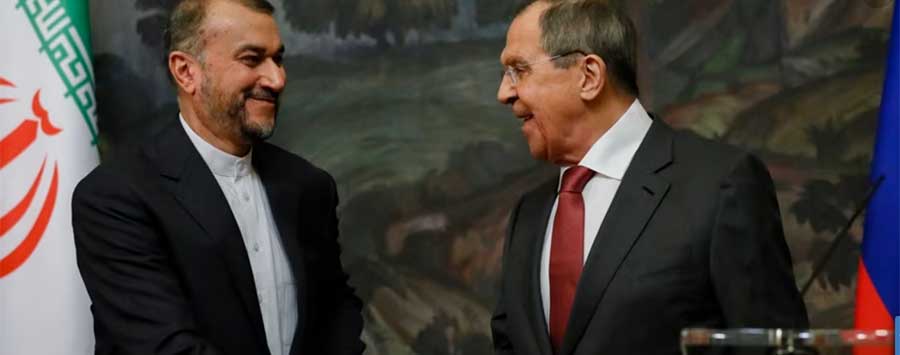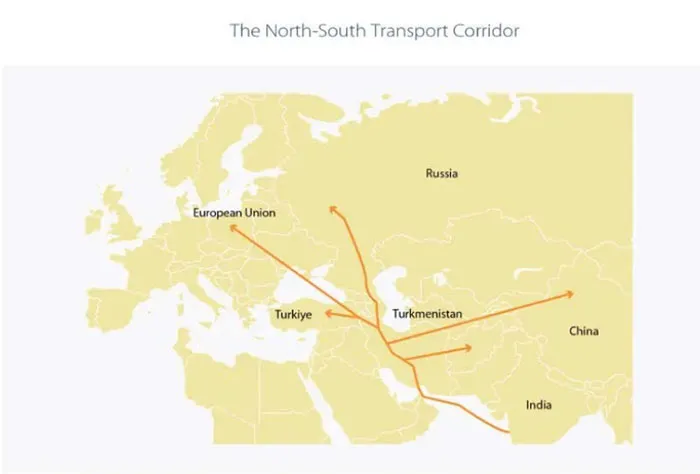Iran, Russia Engage in Talks Concerning Israel Conflict and Bilateral Trade & Development

Iranian Foreign Minister Hossein Amir-Abdollahian (left) with Russian Foreign Minister Sergey Lavrov.
The INSTC and suppressing the Israel-Palestine conflict are both high on the bilateral diplomatic agenda
By Emil Avdaliani with additional commentary by Chris Devonshire-Ellis
Iran’s Foreign Minister, Hossein Amir-Abdollahian has been hosting talks with the Russian Foreign Minister, Sergey Lavrov, and has been discussing expanding bilateral cooperation within high-level agreements in Tehran, according to the Russian Foreign Ministry, who stated “The current bilateral agenda was thoroughly discussed, with an emphasis on the further development of the entire complex of the multifaceted Russian-Iranian partnership in accordance with the agreements reached between Russian President Vladimir Putin and Iranian President Ebrahim Raisi.”
The parties highlighted the implementation of joint projects in energy and logistics, including the full launch of the North-South international transport corridor. Additional steps to further strengthen Russian-Iranian ties have also been agreed. In this article we examine their bilateral trade relations.
Both Moscow and Tehran stressed the unacceptability of unilateral Western sanctions that “undermine the normal functioning of the global economy.” Moscow and Tehran will also have discussed dampening down the current Israel-Palestine conflict.
In many ways Russia and Iran find themselves in a similar geo-strategic position. Both are heavily sanctioned by the West and pursue a set of policies which aim at bolstering their respective influence on their regional, if not global stage.
They also work to diminish the collective West’s ability to shape the world order and limit Eurasian powers’ projection of power. These wider incentives serve as a major driver behind the expanding cooperation between Russia and the Islamic Republic.
Given the sanctions imposed on Russia and the latter’s wide-ranging attempts to re-orient trade from the EU to Asia, Iran stands to benefit significantly. This has already been evident throughout 2022 in terms of growing bilateral trade or mutual investments. The trends indicate the figures are likely to grow in 2023 and much beyond.
Iran – Russia Trade
In 2022, the trade turnover between Russia and Iran increased by 20% and amounted to US$4.9 billion. Existing trends indicate that the bilateral trade will continue to grow in 2023 beyond. Russian officials even suggested that it would be possible for two countries to reach a staggering US$40 billion mark in bilateral trade.
Since 2019, an interim Free Trade Agreement (FTA) has been in force between Iran and the Eurasian Economic Union (EAEU). Supposed to expire in October last year, it was extended until 2025 or until the entry into force of a new agreement on a permanent free trade regime. In January 2023, the EAEU and Iran signed an agreement to create a free trade deal which is expected to come into force by the end of the year.
Russian exports to Iran mainly consist of metals, food and agricultural raw materials, equipment and vehicles, products of the chemical industry and others. Imports from Iran are made up of food and agricultural materials, pharmaceutical products, textiles and footwear, various machines and similar items.
Following the visit of deputy prime minister of Russia, Alexander Novak, to Iran in May 2022, it was announced that the two countries agreed to switch to trade settlements in Rubles and Rials as much as possible, and also discussed the possibilities of operation of Shetab and Mir payment cards.
A year later Russian officials claimed that around 80% of trade settlements between Russia and Iran are carried out in their respective national currencies. The remaining 20% is in US Dollars and Euros with even this expected to be supplanted by the Chinese Yuan in the future.
In 2023, Russian and Iranian media reported that Russia and Iran were discussing the development of a common stablecoin – a cryptocurrency backed by gold – often regarded by Russian and Iranian officials as a potentially viable alternative to the US dollar’s dominance in global trade.
Iran – Russia Investments
In 2022 Russia became the largest foreign investor in Iran, contributing US$2.76 billion (investment into two oil projects) to the country’s economy, which is nearly 2/3 of the US$4.2 billion that Iran attracted in total. FDI into Iran generally is also increasing – the US$4.2 billion is in itself significantly higher than what was recorded in 2021 when Iran received US$1.45 billion in foreign direct investment. Iran’s recent rapprochement with Saudi Arabia will also be an FDI spur into the country.
By early 2022 the largest joint investment project between Russia and Iran was the construction of the Bushehr nuclear power plant in Iran. In June 2021, the implementation of another project to create a thermal power plant (TPP) Sirik in the province of Hormozgan in southern Iran began with Russian investment in the form of a state loan.
As Russia came under Western sanctions its push for closer investments ties with Iran became especially apparent by mid-2022. For instance, in July the National Iranian Oil Company and the Russian giant Gazprom signed a memorandum on energy cooperation which envisioned Russian investments of US$40 billion into Iran’s oil and gas industry. The Iranian side however has complained numerous times that only a small amount of the promised investment has arrived to date and that scheduled payments have been delayed.
Large scale cooperation likewise takes place around the International North-South Transportation Corridor (INSTC), which aims at connecting Russia with the Global South and thus facilitating its re-orientation of trade from Europe to Asia. In May 2023 Russia agreed to make another a significant investment into Iran by financing the still incomplete 162-km-long Rasht-Astara railway section in the north of Iran. This will shorten the travel time for products from Russia to Iran and vice versa. The project is scheduled to be completed by 2027 and is being financed by the Russian side. The total investment amounts to US$1.6 billion, with work underway. As this is a key connectivity issue for Russia’s pivot to Asia, funding has not as yet been an issue.
The expansion of the much-touted corridor, however, has not yet come to full fruition. For instance, in 2022 about 14.5 million tons of cargo was transported along the western branch of the corridor (i.e via Azerbaijan), while 121 million tons were sent via the major Azov-Black Sea route. The difference is striking meaning that the INSTC, though it indeed has a significant potential, at the present is merely a route of regional significance rather than being a transcontinental corridor, an issue we discussed in part here. Modest expectations are that by 2030 total throughput through the western branch will reach 30 million tons per year, while total cargo transportation through all three routes will hit 45 million tons.
Iranian and Russian authorities are exploring another investment possibility through establishing a joint shipping company as part of efforts to strengthen strategic cooperation. This fits into a growing cooperation between the Russian regions bordering the Caspian Sea, and Iran’s northern territories.
In July the head of the Astrakhan region, Igor Babushkin, proposed creating shipping lines between the two countries’ ports. Iran and Russia have several active ports in the northern and southern parts of the Caspian Sea: including Makhachkala, Astrakhan, and Solyanka on the Russian coast, and Astara, Enzali, Nowshahr and Amirabad on the Iranian side.

This area is especially interesting to Iran which has actively invested in Russia’s Caspian ports. For instance, the controlling stake in Astrakhan Port PJSC (53.1%) is owned by Iranian Nasim Bahr Kish CJSC. Russia owns 25%, while the rest is privately held.
Tehran and Moscow are also working the creation of an energy hub in a bid to establish a system which will provide stable gas prices, minimize competition between Russian and Iranian gas and prevent foreign interference. The two countries also agreed on development of a partnership for the production and maintenance of civil aircraft. It requires the development of the necessary infrastructure, with China and India also interested in participating.
This is linked to the ongoing bilateral work in signing a services and investment agreement, given that the countries aim at intensifying cooperation across as diverse areas as energy, transport and logistics, finance, digital economy and technology, engineering, and tourism.
Russia and Iran may be largely shunned in the West, but elsewhere they have proved adept at working around sanctions issues and creating new opportunities. Today, they are key actors in preventing further conflict in the Middle East – an issue largely ignored in the West. But with both having significant regional investments and, in the case of the INSTC, vital regional connectivity, neither will want to see escalation.
Emil Avdaliani is a professor of international relations at European University in Tbilisi, Georgia, and a scholar of silk roads.
Related Reading
- Iranian Cargo Transit Up 8.24% Y-o-Y In The Past Six Months
- Russia, Iran Discuss Tehran’s Coming BRICS Membership
- Russia and Iran Connect Financial Payment Systems
About Us
Middle East Briefing is one of five regional publications under the Asia Briefing brand. It is supported by Dezan Shira & Associates, a pan-Asia, multi-disciplinary professional services firm that assists foreign investors throughout Asia, including through offices in Dubai (UAE), China, India, Vietnam, Singapore, Indonesia, Italy, Germany, and USA. We also have partner firms in Malaysia, Bangladesh, the Philippines, Thailand, and Australia.
For support with establishing a business in the Middle East, or for assistance in analyzing and entering markets elsewhere in Asia, please contact us at dubai@dezshira.com or visit us at www.dezshira.com. To subscribe for content products from the Middle East Briefing, please click here.
- Previous Article Israel’s Relationship With The Gulf Cooperation Council
- Next Article Saudi Arabia and Indonesia’s Bilateral Trade: Status and Prospects


